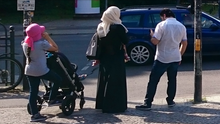headscarf
A headscarf is a piece of fabric, usually triangular or folded into a triangle, with which the head is covered. It can be worn in different ways, usually tied under the chin or in the neck, but also hanging loosely or in other variants. There are many reasons for wearing a headscarf: mainly practical, cultural and religious reasons, but also fashion reasons.
Headscarves are mostly worn by women and children, but there are also headscarves for men . The protective function of a headscarf or other headgear is particularly important for small children.
Reasons for wearing a headscarf
Headscarves are mainly worn for practical, cultural or religious reasons. The practical reasons include protection against the weather (cold, heat, wind, sun) and protection against pollution, for example in dusty environments. A headscarf can ensure that the hair does not interfere with work. In some cases, suitable headgear is required as occupational safety . For example, long hair must be prevented from getting caught in rotating parts of machines, either by wearing suitable headgear (hat, hairnet or headscarf) or by pinning the hair on. For hygienic reasons, headgear must be worn in kitchens and hospitals, for example. Religious regulations and customs are also often the reason for wearing a headscarf for women (see veil ).
Culturally, the meaning of the headscarf or the veil has changed in all parts of the world. A headscarf belongs to many women's costumes. In Western Europe, until the second half of the twentieth century, many women wore the headscarf out of tradition , in other European countries the tradition has been preserved to the present day. Indian women often wear a sari and cover their hair with a long piece of cloth. A headscarf can serve as an ornament or a fashion accessory. The headscarf can also be seen as part of the identity of the wearer and express belonging to a social group . Something similar is known of the male Sikhs and the wearing of the turban .

The headscarf can also express an ideological or political conviction. One example of this is the Madres de Plaza de Mayo , which attracted special attention during their protests by wearing white headscarves.
Headscarves for women
The headscarf in the western world


Wearing headscarves was common in Europe, especially in rural areas, until the 1980s. Wearing a headscarf was particularly common in the post-war period among rubble women to protect their hair from dirt.
The headscarf experienced a renaissance in films of the 1950s and 1960s, especially with Audrey Hepburn and Grace Kelly (including in Breakfast at Tiffany's and Above the Rooftops of Nice ), whose name is now also worn in a certain way (under the chin crossed and then knotted in the neck) is linked. The currently best-known woman in the world who often wears a headscarf is probably Queen Elizabeth II , who has already been positively mentioned by British Vogue for this reason .

The use of the headscarf first declined in the cities and later also in rural areas; it was largely supplanted by other items of clothing such as hats or caps. Today it is also common practice not to wear any headgear at all. Ingrid Loscheck states that “after around 1960, headgear fell out of use in both sexes”.
The headscarf is common in many Eastern, Central and Southern European countries. There it is worn regularly at church services, but also often in everyday life.
Headscarf and religion
Judaism
In Orthodox Judaism , it is customary for married women to cover their hair as part of zniut ("modesty"). The headscarf often worn here is called Tichel or Mitpachat. It identifies the wearer as a married woman. The Tanach already reports of a veiling of women: This is how Rebekah , Isaac's future wife, veils herself .
“Rebekah looked up and saw Isaac. She let herself down from the camel and asked the servant: Who is that man who is coming towards us in the field? The servant replied: This is my master. Then she took the veil and covered herself. "
Christianity

In Christianity today, the headscarf is mainly worn by women of the Orthodox Churches , the Brethren movement and in some Mennonite or Anabaptist communities such as the Hutterites . White polka dots on a black background are prescribed for the headscarves of the women of the Hutterite blacksmiths , making them particularly easy to recognize.
A veil that resembles a headscarf belongs to the habit of the sisters of some newer congregations, such as the Little Sisters of Jesus and the Little Sisters of the Lamb .
The commandment derived from the Bible that women cover their heads or hair during prayer and worship is practiced in some churches, especially in Eastern and Southern Europe . In isolated Brethren congregations , in the Roman Catholic and Orthodox Churches , in Pentecostal congregations , Norwegian congregations , Calvinist congregations in the Netherlands and Scotland, and in the congregations of Baptist emigrants from the former Soviet Union, many women cover their heads while praying and refer to themselves here on the apostle Paul :
“But a woman dishonors her head when she prays or speaks prophetically and does not cover her head. It is then in no way different from a shorn. "
Islam
Only three verses in the Qur'an deal with dress codes for women. Of these, one relates only to the women of Muhammad (33.53), a second to these and the Muslim women (33.59) and a third to the Muslim women and men (24.30-31). All three were proclaimed between 626 and 627, when Mohammed was already living in Medina as the political leader. There is no mention in the verses that the woman should cover her hair or cover her face. The headscarf is therefore not derived from the Koran, but is explained by regional culture and tradition. There are also traditions of the Prophet Mohammed ( Hadith ), which express themselves about the covering of women. How they are interpreted and what status they have depends on the believer.
In the West and also by liberal Muslims, the Islamically motivated headscarf is often viewed critically. It is rejected as a symbol of Islamic patriarchy , as a means of exerting pressure against women or as a “symbol of gender apartheid”. The European Court of Human Rights in Strasbourg resolved the question of whether wearing a headscarf was a fundamental right of Muslims in Europe in a judgment of May 2004. The judgment justifies the dismissal of the suit - it was not only decided that this fundamental right does not exist, but also found that a headscarf ban is even permissible, i.e. not a violation of human rights. As early as 2001, the same court dismissed the action brought by a Muslim teacher from Switzerland who wore a headscarf and had been forbidden to continue teaching with a headscarf under reference to the secular constitution of the canton of Geneva .
In Islam there are very different reasons for women to wear a headscarf: custom, religious self-image, individual self-expression (headscarf as an accessory ), regulation (e.g. due to laws in some Islamic countries), pressure from the social environment, symbol group membership, and (in rare cases) expression of protest.
Headscarves for men

In western countries the headscarf for men is traditionally handed down as headgear by pirates , although it is not certain what is fact and what is legend.
In the Swabian-Alemannic Carnival, a headscarf is part of the traditional costume of many fools , especially the witches' guilds during the processions.
Currently, the bandana (from Hindi bandhana , "to tie") is occasionally found in men . A bandana is smaller than a "normal" headscarf (usually only 50 to 60 centimeters edge length) and is worn like a pirate headscarf. It can serve as a fashion accessory or as a protection against solar radiation. A bandana can also be used to express a certain group membership.
In the Arab world, men wear the keffiyeh as the usual headgear , often with a red and white or black and white pattern or monochrome. In Oman , a scarf is wrapped around the head using a special technique that is reminiscent of a turban .
The men of the Sahara peoples , such as the Tuareg , Peul , Tukulor and Mauritanians , cover their heads with a cloth to protect them from sun, wind and sand, usually in a shape reminiscent of the turban. The Tuareg's Tagelmust is also called Chèche in French . It consists of a rectangular piece of cotton fabric that is between four and ten meters long. It covers the man's face, only the eyes remain free.
Others
One of the first women's soccer teams was called "Eintracht Kopftuch".
literature
- Sabine Berghahn, Alexander Nöhring; Petra Rostock (Ed.): The stuff of which conflicts are made. Debates about the headscarf in Germany, Austria and Switzerland. Transcript, Bielefeld 2009, ISBN 978-3-89942-959-6 .
- Monika Höglinger: Veiled worlds - on the meaning of the headscarf for Muslim women; ethnological study. Foreword by Andre Gingrich, afterword by Barbara Frischmuth. 2nd edition, Edition Roesner, Maria Enzersdorf 2003, ISBN 3-902300-03-5 .
- Peter Kühn: The headscarf in the discourse of cultures. Bautz, Nordhausen 2008, ISBN 978-3-88309-221-8 .
- Meral Akkent, Gaby Franger: The headscarf - Basörtü. Dagyeli Verlag, Frankfurt 1996, ISBN 978-3-924320-61-4 .
See also
Web links
- Ingrid Thurner: The headscarf: the stuff that prejudices are made of . In: Die Presse , January 16, 2010.
- Video interview with Reyhan Sahin about the meaning of the Muslim headscarf August 26, 2013
Individual evidence
- ↑ Occupational safety needs to be learned - a guide for safety officers . Accessed April 30, 2020 . (PDF). Berufsgenossenschaft Holz und Metall, January 2013, p. 14: Protecting hair .
- ^ Kitchen hygiene , Federal Ministry of Health, Austria, 2013, p. 18
- ↑ Tell me: What does the headscarf mean? , at badische-zeitung.de, accessed on July 9, 2015 at 8:09 am
- ↑ Headgear as a political issue , on orf.at, accessed on July 22, 2018 at 5:10 p.m.
- ^ Dpa / wal: Award: Elizabeth II elected Glamor Queen. In: welt.de . November 5, 2007, accessed October 7, 2018 .
- ↑ Ingrid Loscheck: Reclams fashion and costume lexicon. Stuttgart 1999, pp. 311 ff, 143f
- ↑ Claudia Knieps: Does the Koran prescribe the headscarf? The religious debate . Ed .: Federal Agency for Civic Education. ( bpb.de [accessed on February 13, 2019]).
- ↑ Christoph Zotter: What is the religious background of the veil? | NZZ . May 18, 2017, ISSN 0376-6829 ( nzz.ch [accessed on February 13, 2019]).
- ↑ Kacem El Ghazzali: The Islamic headscarf is a symbol of patriarchy and not of self-determination | NZZ . October 12, 2017, ISSN 0376-6829 ( nzz.ch [accessed February 13, 2019]).
- ↑ Frankfurter Rundschau (ed.): Islam reformer criticizes headscarves for women . March 9, 2018 ( fr.de [accessed February 13, 2019]).
- ↑ Deutschlandfunk (Hrsg.): Critique of Islam: “The headscarf is a symbol of gender apartheid” . April 7, 2017 ( deutschlandfunk.de [accessed February 13, 2019]).
- ↑ Cf. Bassam Tibi : “With the headscarf to Europe?” Wissenschaftliche Buchgesellschaft , 2005, p. 12
- ↑ Cf. Heiner Bielefeldt : “On the current headscarf debate in Germany. Comments from the perspective of human rights ” , German Institute for Human Rights , Berlin, May 2004, p. 6
-
↑ ( Creative variations on the subject of veiling - Qantara ),
bathing in burkini ( Deutschlandradio ),
headscarf fashion: Das Accessoire des Islam ( Das Accessoire des Islam - FAZ ),
Integration: Die Schöne Töchter Kreuzberg ( The beautiful daughters of Kreuzberg - FAZ ) - ↑ Ehrhart Körting: "The state must be neutral" , DIE WELT, March 11, 2004
- ↑ How to wear a Shmagh on YouTube
- ↑ Eintracht headscarf against FC United pantyhose , on elbe-wochenblatt.de



